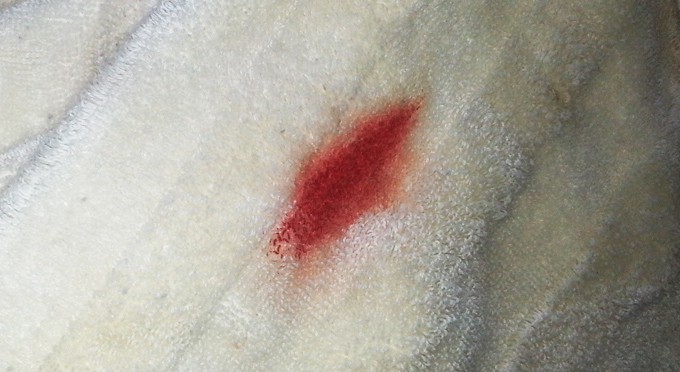 Blood stains can be pretty horrific due to the intense red color, and it’s extra annoying when the scarlet fluid saturates lightly colored fabrics. Contrary to what it might look like, the image above wasn’t taken ringside after a boxing match, but it does depict a rather large blood stain on a cream colored towel. In this case, it’s just a regular bath towel, but it wasn’t used to mop up after an epic battle, it was used to come to a quick rescue when a loose tooth decided to hang on tight, and the six-year-old owner had other ideas. The fresh blood completely soaked into the cotton fabric, and unless treated properly, it was guaranteed to become a permanent stain.
Blood stains can be pretty horrific due to the intense red color, and it’s extra annoying when the scarlet fluid saturates lightly colored fabrics. Contrary to what it might look like, the image above wasn’t taken ringside after a boxing match, but it does depict a rather large blood stain on a cream colored towel. In this case, it’s just a regular bath towel, but it wasn’t used to mop up after an epic battle, it was used to come to a quick rescue when a loose tooth decided to hang on tight, and the six-year-old owner had other ideas. The fresh blood completely soaked into the cotton fabric, and unless treated properly, it was guaranteed to become a permanent stain.
All stains are easier to remove when treated right away, but this is especially true when it comes to blood. If allowed to dry, or if set in place in some way, the spot will be more difficult to get out, and it may be there forever. If you act quickly, then several techniques will get the material clean, but the longer you wait, and the more mistakes you make, the tougher the job will be.
Please Note: Never use hot water when cleaning a blood stain. The heat will react with the iron and hemoglobin to create a stronger bond, and the stain will quickly become way more difficult to eliminate. Cold water should be used at all times when rinsing, flushing or laundering fabrics with blood stains.
Popular Ways To Remove Blood Stains
- Just Rinse It – If you act quickly enough, fresh blood can be rinsed away with plain old water. If the stain is new, you can try flushing the red out under the tap with cold water.
- For clothing, just rinse in the sink, shower or tub, using the coldest water setting possible.
- For best results, turn the garment inside-out so that you can easily rinse from back to front. This ensures that you wash the blood out instead of pushing further down into the material.
- Continue rinsing until all color washes out. Rub the material against itself to loosen any stubborn spots.
- To finish, launder with cold water and regular detergent.
- If the stain were on carpet or upholstery, use a bowl of ice water and a sponge or towel to blot the stain away.
- Hock a Loogey – It may seem gross, but with delicate fabrics, saliva can be a good option to loosen and remove the red spot. It’s only practical for newly formed stains that are small in size, but when applied to the blood, enzymes in your spit will break down the proteins that help the blood cling to the material. With enough work, and careful attention, this method will take out simple spots, and because there’s no risk of damage, it’s often recommended for delicate fabrics.
- Apply saliva to the stain by spitting right on it.
- Once the loogey is in place, spread and rub into the area gently.
- After treating with spit, rinse from back to front under cold water to flush out the stain.
- The saliva should loosen and remove fresh blood to allow for elimination of the stain, but repeat if necessary, and then launder with cold water and detergent to finish.
- Shake It Up – sprinkle some salt into water, and mix to create a paste. This salt solution acts as a delicate cleanser that can be effective in some situations. You’ll need enough paste to cover the entire spot, so the exact amount of salt and water need will vary between applications. It’s important that the paste is thick, and course salt is probably the best. As you rub it into the stain, the salt will act as an abrasive to loosen the blood, and it will also act as an agent to draw out, and remove the grime from the fabric.
- Concoct your stain fighting solution separately, and then apply it to the stain. You don’t want it to be liquid-y at all. The water is to cause the salt to stick and become paste-like. Once you have a thick, course paste, you are ready to clean.
- Apply a generous layer over the whole stain, then rub gently to lightly scrub the material.
- Once you work the salt in, and give it time to draw out the blood, rinse with cold water to remove the loosened grime.
- Repeat as needed for stubborn spots.
- Once the fabric has been treated with your homemade salt solution, launder with cold water and detergent to finish.
- Soap It Down – Regular hand soap can be surprisingly effective on newly stained clothing, so if you’re on the go, head to the bathroom to get your shirt clean. A few pumps of liquid soap combined with cold water is often sufficient to wash out small spots that are new. You won’t want to try this on set in stains, or larger areas of color, but the powerful cleaning agents in hand soap are often enough to lift out this natural stain.
- To try this method, wet the material first, and attempt to rinse out any blood that is possible. Make sure to use cold water.
- Once the area is wet, apply a liberal amount of liquid soap, and gently work it in. Be careful not to spread the stain.
- Once the red stuff is loosened by the suds, rinse with cold water again to flush the material.
- Blot dry and then go about your day, or launder right away to ensure a thoroughly cleaned garment.
- Brush Your Chops – For dried on blood, you may need something a bit more powerful. The pasty kind of toothpaste can be an effective cleanser, and it seems to work well on blood that has dried on certain fabrics. The ingredients will help to release the bond between the blood and the fabric, and aid in drawing it up and out of the material. You wouldn’t want to use it on anything you can’t wash afterward, but for clothing, that part is easy. Most of us have some in the bathroom, so this is a remedy that you can try when nothing else works, or nothing else is available.
- To begin this method, simply apply the paste to the stain, and rub lightly.
- Cover the area completely, and then let the toothpaste dry.
- After it dries, rinse the spot with cold water, and then launder like normal.
- Get Serious – In more extreme cases, or as a last ditch effort, you can try hydrogen-peroxide to bleach out the stain. This volatile substance can damage, lighten, or stain certain materials, so be certain that you won’t amplify the problem by trying this method. If used at the right time, it can make red spots disappear almost instantly. It works best on fresh stains where the blood is still wet, and is often used to clean surfaces like floors, counters and tables. It will also eliminate the gruesome grime from many types of clothing, but it acts like a bleaching agent, so you’ll need to be careful.
- Use full strength hydrogen peroxide on regular fabrics. For delicate fabrics, try a 50/50 solution diluted with water.
- Pour directly onto the stain, and be careful to ensure the resulting foam does not spread outside the original area.
- As the reaction dies down, blot the area, and reapply. Keep this up until the color is lifted.
- After treating with peroxide, rinse with cold water, and then wash with regular detergent.
- Tender Loving Care – Meat tenderizer is often used to remove set in blood stains, but it’s only safe for tough fabrics like jeans. If you have a red spot that has been washed or dried in place, and nothing else works, you might try this culinary additive as a method to remove it. Blood and meat are similar because both break down over time when they encounter enzymes like protease and cellulose. It turns out that the same ingredients used to make cheap cuts easier to chew will also help loosen the grip of tough blood stains on fabric.
- Only try on sturdy fabrics, and make sure to select a tenderizer without seasoning. Linen, silk and wool may be damaged by this stuff, so stick to cotton and other materials when trying it.
- Get a large bowl and add a small amount of cold water.
- Place the affected piece of clothing into the bowl so that the stained portion can lay in the water to remain slightly saturated.
- Sprinkle tenderizer over the red spot and massage it in.
- Let it sit for up to a day, but repeatedly massage and re-apply tenderizer every 30 minutes in order to work the stain free.
- Once finished, rinse with cold water, and then wash with regular detergent.
An Easy Way To Clean A Blood Stain
The above methods are widely recommended. All of them will work in certain situations, but depending on the technique you try, you may have to act quickly to have any luck, and none will be equally safe and effective on all types of clothing. The directions that follow will outline the steps taken to remove the bright red blood stain from the cream colored bath towel in the photo. In this case it was a fairly fresh spot, but the same technique would also work for one that was dried in place, or set in by washing.
Stuff You’ll Need
- Cold Water
- Towel or Rag
- Quick N Brite Paste
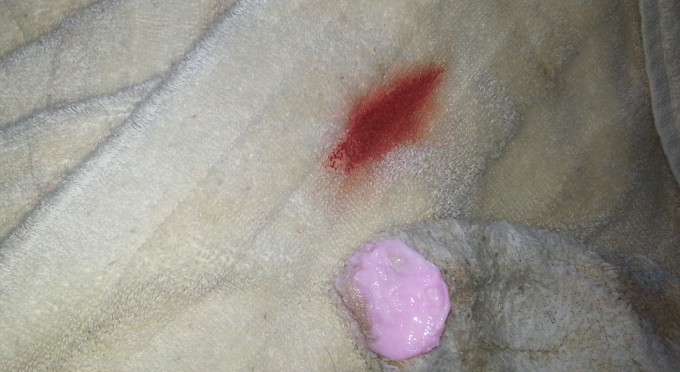 Step 1
Step 1
To begin cleaning the stain, we took a clean towel and got it wet with cold water. The towel was used to gather a good amount of cleaner, and it was applied directly to the spot. Because the affected area was relatively small, and also new, we skipped the initial step which may be necessary in other cases to achieve perfect results. If you are working with a larger spot, or one that has dried in place, rinse the spot from back to front with cold water first. This will eliminate any blood that’s possible in order to make the stain removal process easier.
For this average size spot of still wet blood, quickly attacking it with a saturated rag and some cleaner proved to be more that sufficient to get the job done.
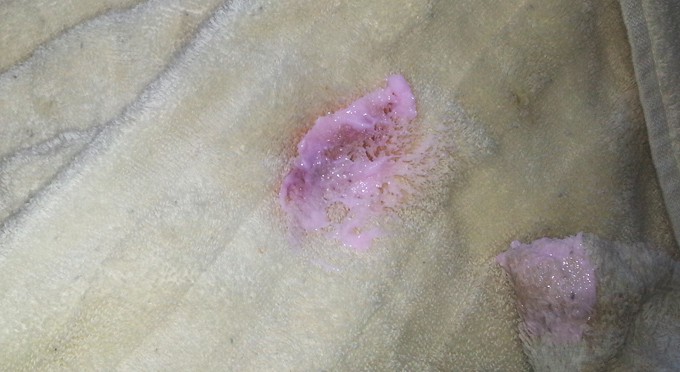 Step 2
Step 2
As you apply the cleaner to the stain, work it in gently by rubbing up and down, and back and forth with the wet towel. As you massage it in, be careful to avoid spreading the stain. Once you have it applied, let it sit for 10-20 minutes. Just like the saliva and tenderizer above, this cleaner is an enzyme. As you let it sit, it will do the job for you by breaking down the organic material, and releasing its bond with the material. Although it is powerful at cutting through grime, it’s also safe for any type of fabric, so use it with confidence no matter which shirt, dress, or tie it is that you got dirty.
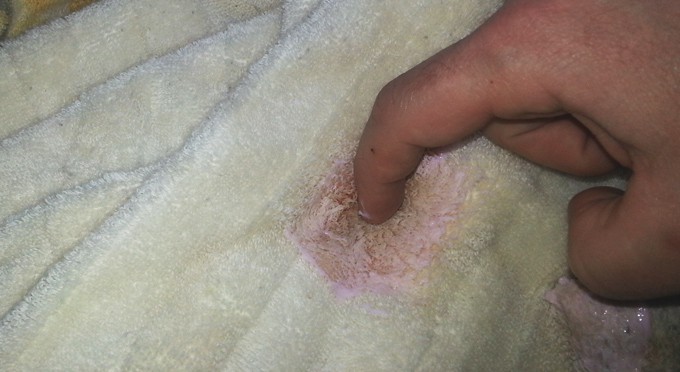 Step 3
Step 3
After it sits for a few minutes, and because this is a towel with thick, plush material, add some additional cleaner, and work it deep into the material. You’ll notice that the blood is already lifting and loosening as you continue to apply the cleaner, and the deep red stain is already several shades lighter. Once you get the cleaner worked in, let it sit again, for another few minutes. Make sure you don’t agitate the fabric too much, or scrub with any force. you only want to allow the cleaner to penetrate the material, and you want to avoid any damage by using too much force.
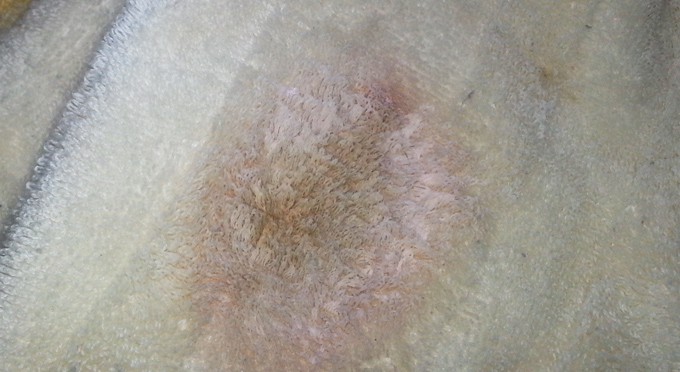 Step 4
Step 4
After it sits, take an unused, but still wet portion of your towel, and buff the area to remove the cleaner. The above picture shows the stained area after a single quick application of the cleaner. The red spot is gone, but a brownish-red discoloration still remains. To continue the process and remove the stain completely, a second application was applied. The same amount of cleaner was smeared in place using the same wet towel, and it was massaged into the stain, just like the first time.
 Step 5
Step 5
After the second application was allowed to sit, it was also removed to reveal the results in the photo above. It was pretty darn clean, but a faint stain still remained, especially deep down in the material. To complete the job, we simply applied one last thin layer of cleaner as a laundry pre-treater, and sent the towel through the wash.
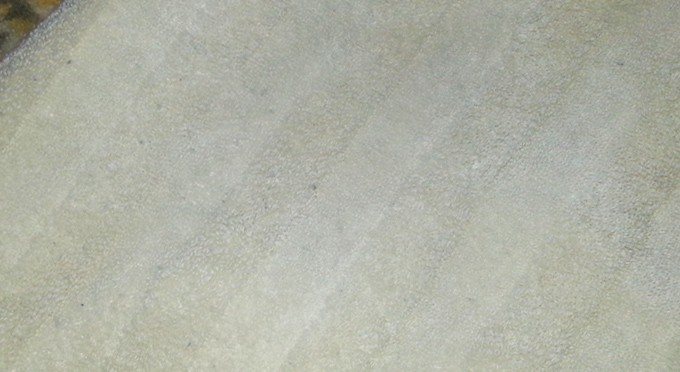 Step 6
Step 6
After one wash cycle with cold water and regular detergent, the terrible stain was completely eliminated, and no sign of it remained.
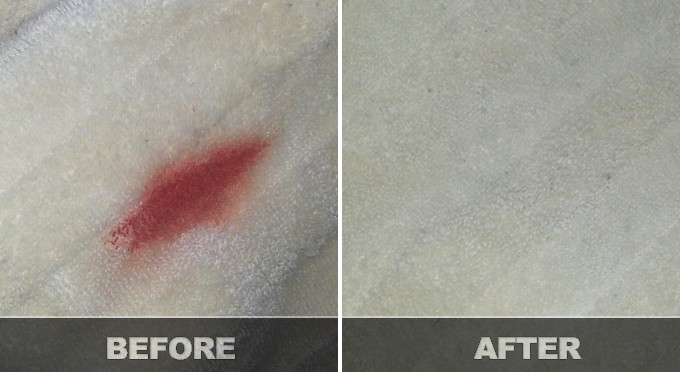 Before And After
Before And After
As you can see by the picture above, the results are dramatic. Against the light background of the bath towel, the vibrant red stain looked impossible to remove, but in a few simple steps, we did clean it thoroughly. It didn’t take any bleach or drastic measures to make the cream colored fabric look like new again, and we never ran any risk of damage to the towel. One of the home remedies may have worked just as well, but it’s nice to avoid sifting through a list of possible options by sticking to one that you know will work.
When you choose Quick N Brite to clean a blood stained piece of clothing, a towel, some bed sheets, or anything similar, you know that you will get the stain out, and you won’t ruin anything in the process. It doesn’t matter if it is crusty and old, gooey and wet, or faded and set in. If you use the method above, you can easily lift any blood stain from any material. It will always be easiest with a new spot, and the smaller the better, but with this powerful yet safe cleaner, no spot will be too stubborn to remove.
Additional Tips
- When choosing a soap for this job, stick to those that are not petroleum based.
- For soap alternatives not mentioned above, try club soda or ammonia.
- Always act quickly with blood stains, and never treat with warm or hot water.
- When trying multiple methods on the same spot, be sure to avoid mixing ammonia and chlorine bleach.
- Always take care when handling blood, especially when it’s not your own.
- Wash your hands thoroughly when the job is finished to get rid of any unwanted germs.
- Do not inhale ammonia.



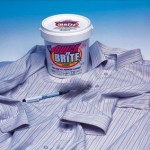
 Ordering Info
Ordering Info Customer Service
Customer Service Follow Us
Follow Us Search For Stuff
Search For Stuff Find Us
Find Us Call Us
Call Us Pay Us
Pay Us

0 Comments so far.
Use the form below to add your own thoughts or questions. Scroll down to read what other people had to say.